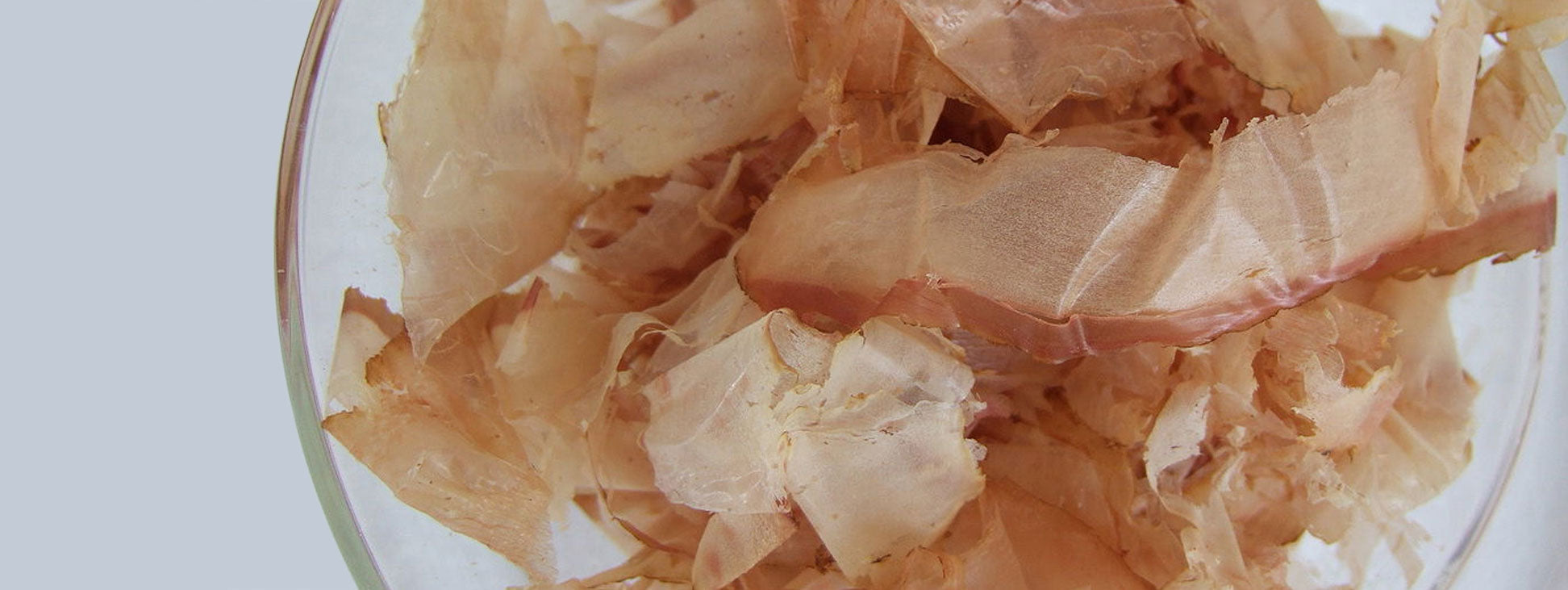Dashi
Home > The Making of Katsuobushi
The Making of Katsuobushi
The main ingredient that makes Traditional Umami Dashi so good

Japanese Food was registered with the UNESCO World Heritage in 2013. The origin of it is dashi. Katsuobushi, the main ingredient in many types of dashi, is made by craftsmen using traditional methods in Japan that have been passed down through generations.

The History of Katsuobushi
Katsuobushi is a delicacy that has been used in Japanese cuisine, since at least the 1600s, and possibly earlier. Made from bonito fish, it is produced in a time-honored method handed down across generations involving a painstaking process of cutting, dry smoking, and fermenting of the fish, resulting in a specialty food with a savory flavor and a long shelf life.
In centuries past, it was used in Shinto rituals, and samurai going into battle often carried it as a food ration, believing it to bring good fortune upon them. In many households, katsuobushi would be shaved off by hand with a special type of plane, and the shavings were used either as a condiment with other foods, or boiled in water to create dashi, or soup stock for cooking. Today it is still used as a condiment and for dashi, made easier in recent decades by the availability of already shaved katsuobushi in packages at supermarkets all over Japan.
- Fishing:
Typically over a period of at least two months, approximately 300 tons of bonito fish are caught in the equatorial region of the western Pacific Ocean. The bonito in this area have a lower fat content than in northern waters. The fish are immediately frozen aboard ship. They are sorted and frozen again in port.
- Defrosting:
At port, the bonito are delivered to the factory, where they are thawed in water and air one day before processing. Carefully controlling the temperature of the water and the fish keeps it fresh and prevents the creation of histamine.
- Raw Cutting:

The process of cutting the raw fish begins early in the morning. This must be started at this early hour, or else total processing will not be completed on time. Excess parts of the fish are removed and the remainder is cut into 3 or 4 sections, depending on size.
- Simmering:

Right after cutting, the bonito fillets are next placed on large hanging trays, lowered into large kettles and simmered in hot water at a temperature of 94°C. Fillets weighing up to 4.5 kg are simmered for 90 minutes. Simmering is important for later steps in the processing of the fillets.
- Boning:

Simmering softens the fish, simplifying the next step, the removal of bones using tweezers. The bones must be removed prior to the next step, the Drying and Smoking of the fillets. Drying and smoking will shrink the size of the fillets somewhat, and since the bones will not shrink, they must first be removed.
- Smoking:

To intensify the umami flavor, the fillets are next lined up in trays and smoke dried by burning oak and related types of firewood in an enclosed space for 3 days. During this process, the air and strength of the fire are adjusted several times by opening and closing the door to the space. Proper smoking resulting in the right flavor of katsuobushi can only be done by expert craftsmen with years of experience.
- Checking moisture levels and adjusting:

Finally, experts will regularly inspect the fillets for the amount of moisture in them, and will make decisions on whether additional drying is needed.

Once the fillets are properly smoked and dried, they are now in a dry, rough shape known as arabushi, which has an exceptionally strong umami flavor.
To make the umami flavor a bit more subtle, the next step is allow a type of mold to grow on them.
Before the mold can be allowed to grow, however, the fillet must be carefully sculpted into a smooth shape by experts in katsuobushi production.
After the mold has grown, it is carefully scraped off and the fillets are then sun dried. At this point, the katsuobushi, now commonly known as honkarebushi, has the consistency of a block of wood. The dried, hardened fish has a smooth, shiny texture on the inside. It is usually shaved either by hand with a special type of plane, or by machine. The shavings have light pink color and are often used in Japanese food to add umami flavor to the dish.

KUZE FUKU & SONS
TRADITIONAL UMAMI DASHI Soup Base & Seasoning, 15-Packet
Made using the same dashi described above, our dashi has a savory, flavor that will add a deep, umami taste to your favorite recipe.
$15.00
Home > The Making of Katsuobushi


